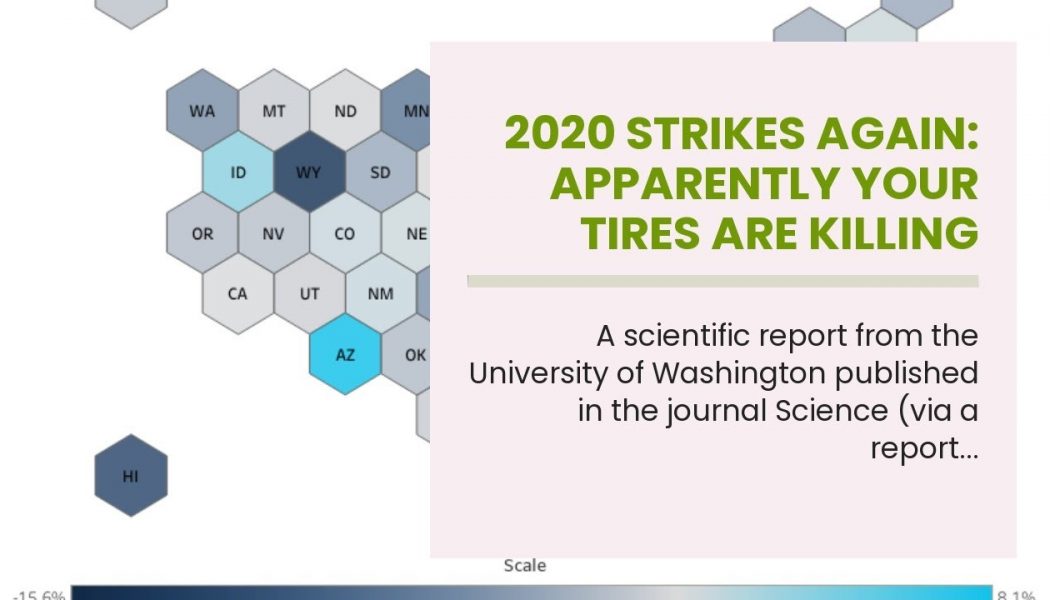A scientific report from the University of Washington published in the journal Science (via a report in The Seattle Times) has linked 6PPD, a near-universal chemical added to tires as a preservative, with the death of coho salmon in the Northwest. And it’s not just a couple of salmon here and there. In some runs, between 40 and 90 percent of the salmon die before spawning due to the symptoms that researchers were exploring, independent of other causes of fish mortality. This issue affects a great deal of the area studied: the Puget Sound. And the culprit, the researchers concluded, is an obscure chemical found in tire dust that is washing into watersheds.
Tires naturally shed tiny particles on the road as they wear down. In this case, this dust then runs into salmon-bearing streams and rivers through road runoff and storm drains. To reproduce the effect, the researchers steeped some very small particles from both new and used tires in water, to which juvenile coho salmon were then exposed. The result was troubling: more than 98 percent of the fish died within two to six hours. And they all exhibited the symptoms that researchers had seen in affected salmon in the field: discoordination, gasping, circling, and eventually death. No fish died in the control groups that lacked the dust, the researchers report.
That left the question of just which component in tires is to blame, as tires are a complicated cocktail of chemicals that all serve different purposes: plasticizers, antioxidants, emulsifiers, and some additional chemicals also known to be toxic. But none of these produced the effects in fish when isolated. So the researchers narrowed in on a chemical known as 6PPD.
The chemical 6PPD, according to the researchers, is a near-universal component of tires. We spoke to Sarah Amick, vice president of environment, health safety, and sustainability and senior counsel at the United States Tire Manufacturers Association (USTMA), who confirmed that 6PPD is indeed an important part of the protection package of additives that manufacturers use to ensure the tires meet the National Highway Traffic Safety Administration’s applicable Federal Motor Vehicle Safety Standards. As the researchers noted and Amick confirmed, 6PPD resists degradation from oxygen, temperature, and ozone exposure.
But in the environment, 6PPD reactions with ozone create a different chemical: 6PPD-quinone. When researchers exposed fish to this isolated byproduct of tire dust, they found the same symptoms and rapid death as in the whole tire dust. Nor is it clear, the study’s authors say, that this only affects coho salmon—it’s just that coho were the subject of the study. You can read the entire report here (PDF file).
It doesn’t appear that this particular compound, 6PPD-quinone, was previously known to be toxic, so it’s not clear if there was any understanding by tire manufacturers that it would literally have downstream effects. That said, a tire-industry research group known as the World Business Council for Sustainable Development’s Tire Industry Project is conducting research into the environmental impacts of tire materials such as the aforementioned dust, according to a statement released by the USTMA. In part, that statement confirms that the USTMA is aware of the salmon toxicity study and is evaluating its conclusions. The European Tyre and Rubber Manufacturers Association has released a similar statement, which you can also read here.
We reached out to several automakers, the representatives of which referred us back to the USTMA. Unfortunately, Amick said it was too premature to discuss alternate tire additives to 6PPD given that the USTMA is still reviewing the University of Washington study.
Dr. Zhenyu Tian at the University of Washington, the lead author of the study, told MotorTrend that there are mitigation techniques already in use that will likely reduce the toxicity of 6PPD-quinone in the environment—techniques like rain gardens and biosoil treatment. But more research is needed on how and where to best treat this type of runoff to protect salmon, and scaling up these solutions to provide adequate coverage could be expensive even if they are otherwise feasible. Over the long term, Dr. Tian hopes that tire manufacturers will find a less toxic alternative that still provides the protection that helps modern tires keep motorists safe.
“We need to find a formula for green tires,” Dr. Tian said, “that is safe for both humans and animals.”










